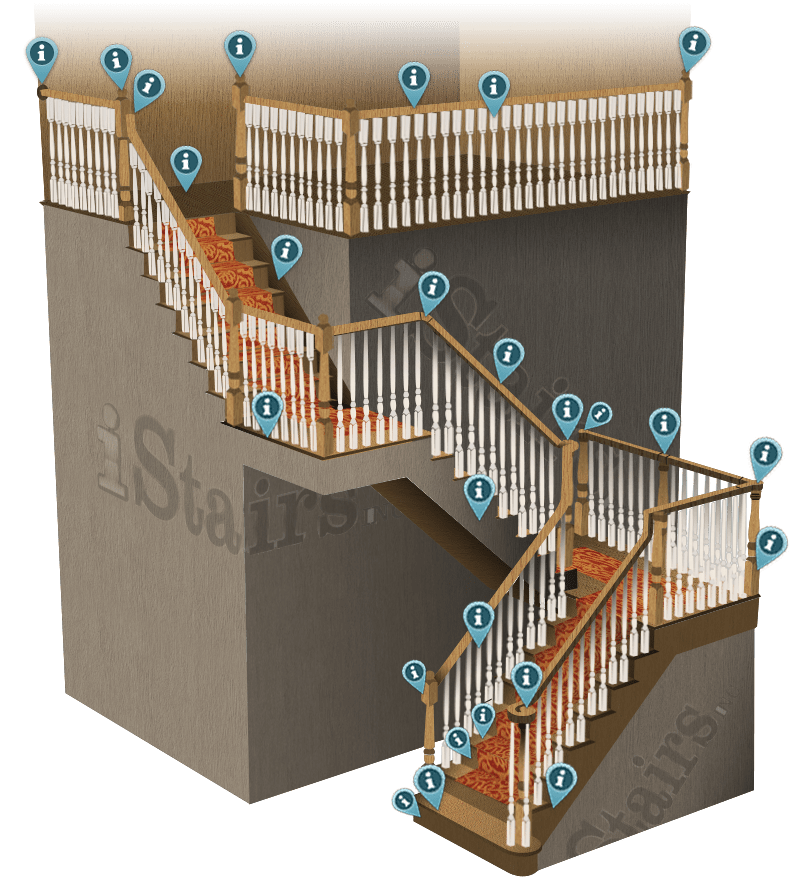Confused about stair parts & terminology? This blueprint should clear that up for you...

1. Oval Rosette
A rosette functions as an elegant termination of a handrail into walls. It can help protect the handrail from flexing, and it can also help the wall from friction caused by a handrail with no rosette.
2. Long-faced Newel
Long-faced newels are used as a transition between handrails on two different levels. By using long-faced newels, the use of a special fitting is no longer necessary. It is best used for connecting horizontal handrails to diagonal ones that decline with the stairs.
3. Gooseneck
Gooseneck fittings are used to connect a lower stair railing to an upper landing railing. There are many available forms of goosenecks that would fit the particular need of any stair design.
4. Starting Newel
Starting newels are support posts that are located at the bottom of a staircase.
5. Plowed Handrail
Plowed handrails are stair railings that are grooved at the bottom that is meant to receive square-topped balusters
6. Square Top Baluster
Square top balusters are vertical posts that support the railing of staircases. Given its square top, it fits well with the groove at the bottom of plowed handrails
7. Half Newel
Half newels are the support posts of a staircase that is connected directly to the wall. Since newels are not usually just a straight rectangular block, if not halved along the diameter, a gap between the newel and the wall would be seen.
8. Balcony
The balcony, more commonly known as the landing, is the level part along a staircase.
9. Wall-Side Skirt Board/ Kick Board
A wall-side skirt board or kick board is the part of the staircase placed in between the wall and the treads. It is used to fill the gap in between the stairs and the wall as to prevent small items from getting into the gap, and for aesthetic reasons as well.
10. Floor Cap
Floor caps are any material (but usually wood) that is placed on top of the tread of a stairs for both protective and visual purposes.
11. Over Easing
A handrail over easing functions like a gooseneck in which it is also used to transition an ascending handrail with a horizontal one.
12. Solid Handrail
A solid handrail, also known as unplowed handrail, does not have a groove at the bottom and works best with pin-top balusters.
13. Gooseneck 180° Fitting
A 180° gooseneck is a fitting that connects the higher and lower level handrails of a staircase in which after the landing, the stairs are rotated by 180° as to save space.
14. Starting Cap
The starting cap or opening cap is a horizontal rail fitting at the beginning of a level balustrade system placed on top of a newel post.
15. Open Stringer
An open stringer stairs have treads that sit on top of the stringer such that the tread could extend past it as opposed to closed stringer stairs that stringers stops the treads.
16. Tandem Cap
Tandem caps are used to connect two separate horizontal railings that with an angle of 180 degrees.
17. Level Quarter-turn Cap
Quarter-turn caps connect two railings with an angle of 90 degrees. Level quarter-turn caps connect horizontal railings.
18. Pin Top Landing Newel Over the Post
Over-the-Post newels allow a single handrail to sit on top of the balusters. A pin top landing over-the-post is a variation of it that is located on a landing of a staircase, and uses pin-top balusters instead of square-top ones.
19. Pin Top Baluster
A pin-top baluster is a post with a rounded head that could fit well into the holes in the bottom of an unplowed handrails.
20. Volute
A volute is circular fitting on a starting newel. It turns away from the staircase for an elegant start for a staircase.
21. Starting Newel Long Turning (Post-to-Post)
Starting newels can be boxed, turned, or circular depending on the stair case design. A long, turning starting newel is an elegant post to start and elegant staircase.
22. False End Tread
False end tread is the step of the stairs in which the covering, like a carpet, ends but not on the first tread. The real end tread is left exposed.er
23. False End Riser
Just like a false end tread, a false end riser the vertical board in between the steps of a stair in which a covering, like a carpet, ends whereas the real end riser is left exposed.
24. Full Across Tread
A step of a stair is not connected to a wall on either side.
25. Full Across Riser
The horizontal board in between the steps of a stair that is not connected to a wall on either side.
26. Open Side Skirt Board/ Kick Board
An open-side skirt board or kick board is used to hide the structural parts of the stairs. Unlike wall-side skirt boards, open side skirt boards are used for those stairs that are not connected to the wall.


